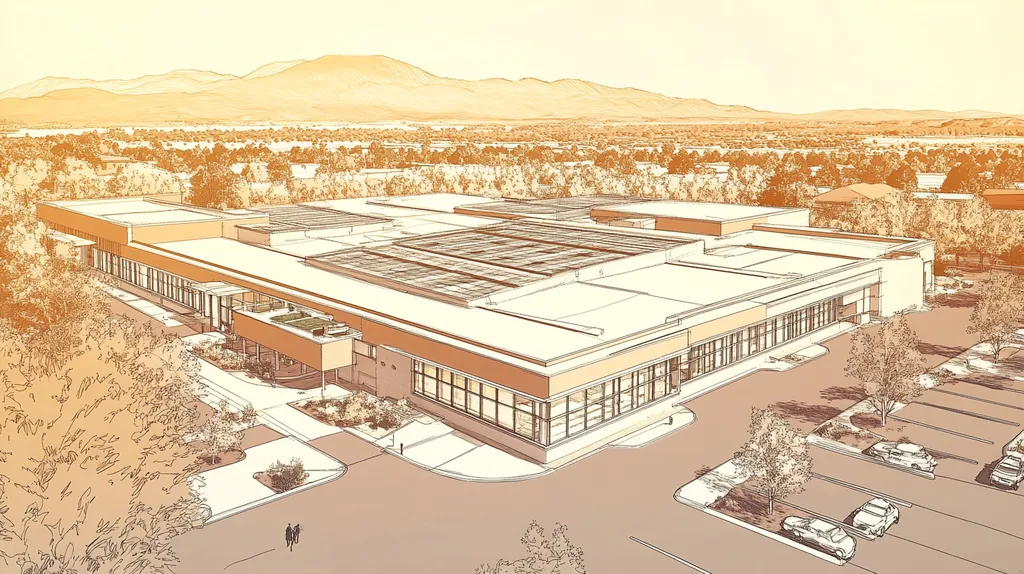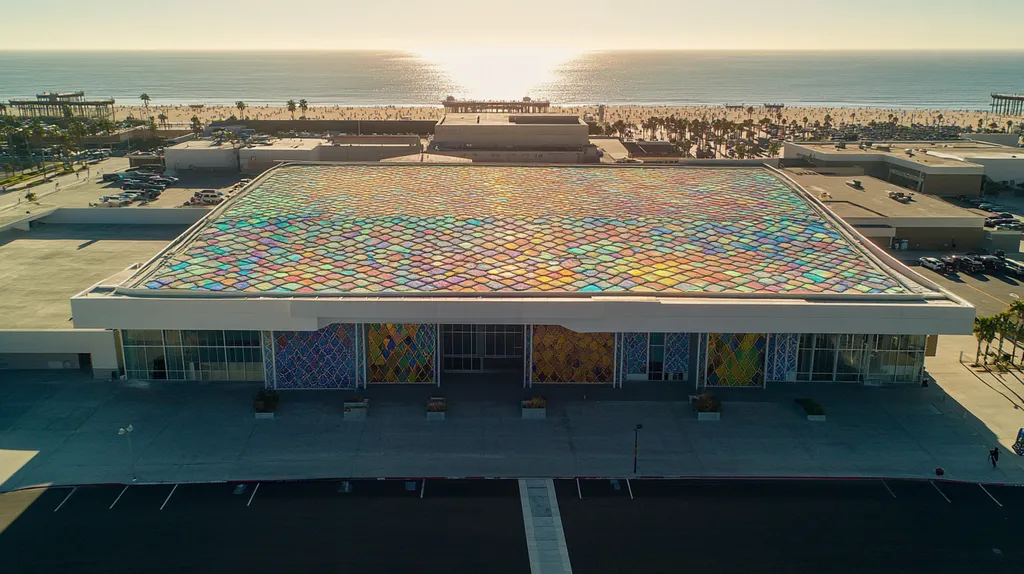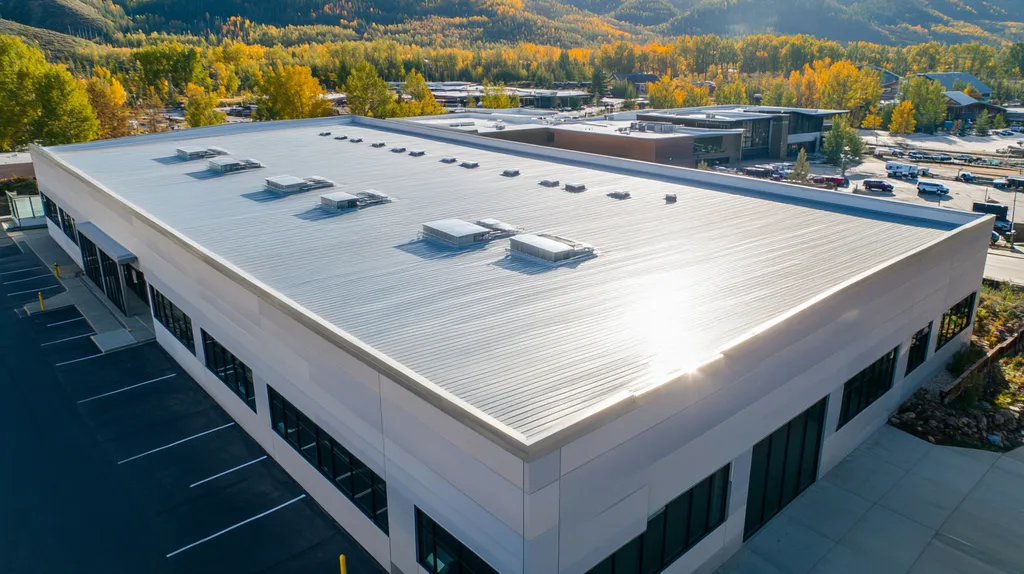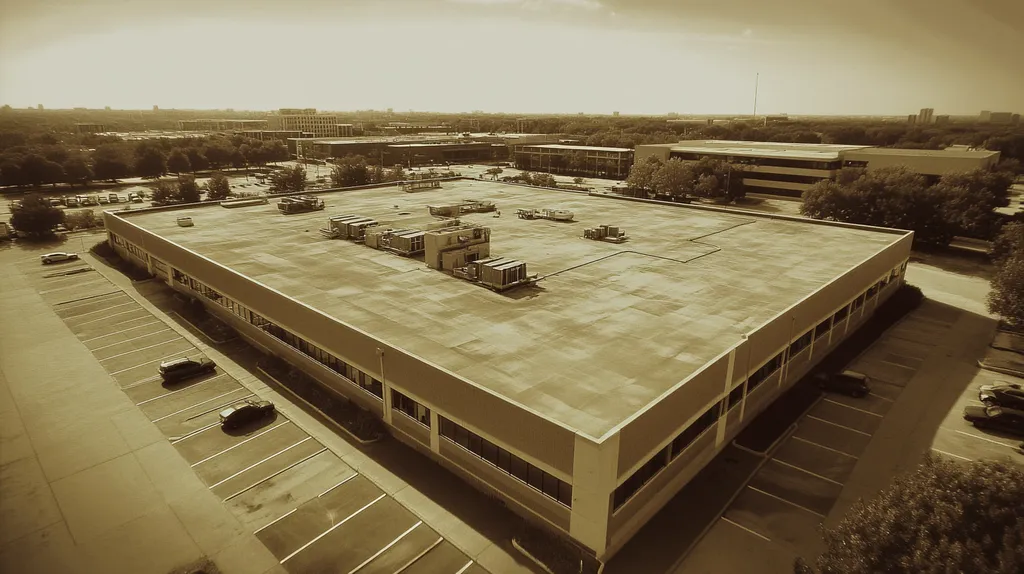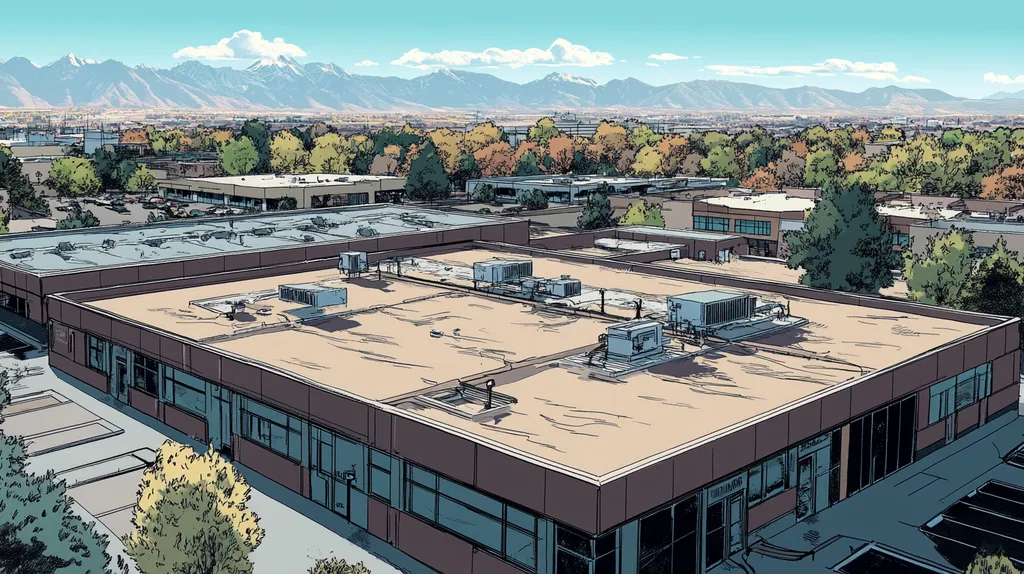Recent industry data reveals that 85% of industrial roof failures stem from inadequate post-installation maintenance, resulting in billions in annual repair costs across North America.
Despite investing significantly in new roofing systems, many facility managers overlook critical maintenance protocols that can extend roof lifespans by up to 25 years while preventing catastrophic failures.
This comprehensive analysis examines common maintenance misconceptions, practical implications of neglect, and evidence-based solutions that protect industrial roofing investments through proper post-project care.
SECTION 1: COMMON MISCONCEPTIONS
Many industrial property owners and facility managers overlook the crucial need for maintenance following an industrial roofing project. Statistics indicate that nearly 30% of roofing problems stem from neglecting routine inspections and preventive care. These common misunderstandings can result in increased costs, diminished roof lifespan, and unexpected disruptions to operations. By addressing these misconceptions swiftly, property owners can protect their investments and promote long-term roof performance.
Ignoring Seasonal Inspections
A prevalent belief among property owners is that a newly installed roof demands little attention in the immediate aftermath. However, seasonal inspections are vital for spotting potential problems before they escalate into major issues. When these inspections are neglected, even minor leaks or the accumulation of debris can lead to substantial structural damage.
Failing to inspect the roof at least twice a year can lead to unexpected maintenance expenses. For example, unchecked faulty flashings and drainage systems can result in water pooling, which may eventually cause leaks. Such issues not only disrupt business operations but can also inflict damage on interior spaces.
Routine inspections guarantee that the roofing system functions as designed and complies with manufacturer warranties. A detailed seasonal review should be a priority to monitor wear and maintain peak performance.
Adopting a proactive inspection schedule exemplifies responsible asset management and commitment to the longevity of property investments. This diligence can prevent costly repairs and emergency interventions.
Delaying Minor Repairs
Another erroneous belief is that minor repairs can be postponed without adverse effects. While a small tear or puncture may appear inconsequential, ignoring these issues can trigger a cascade of larger problems within the roofing system. Delayed interventions often escalate into more significant and expensive repairs.
Even seemingly trivial leaks have the potential to compromise insulation and create favorable conditions for mold growth. Overlooking these repairs can not only undermine the roof’s integrity but may also pose health risks to building occupants.
Addressing even minor issues promptly can extend the overall lifespan of the roofing system. By tackling problems swiftly, facility managers can thwart more substantial damage that could necessitate a complete roof replacement.
Fostering a culture that encourages immediate attention to minor repairs enhances safety and efficiency within the facility. Taking a swift, proactive approach ensures that roofing systems remain in optimal condition, minimizing risks associated with neglect.
Overlooking Roof Equipment Maintenance
Industrial facilities often have various rooftop equipment, including HVAC systems and solar panels, that demand regular maintenance. Neglecting these systems can deteriorate both the roof structure and the effectiveness of the equipment. A compromised roof may allow water infiltration, posing risks to essential machinery.
Many property owners mistakenly believe that maintaining the roof alone is adequate, ignoring the interconnectedness between the roof and the equipment it supports. Regular maintenance of rooftop systems is essential to prevent excessive wear and tear on roofing materials.
Cleaning debris from roof-mounted systems and ensuring that flashings and seals remain intact can avert long-term damage. A proactive approach to equipment maintenance further enhances machine performance, ultimately lowering operational costs.
Integrating maintenance efforts for both the roofing system and rooftop equipment establishes a well-rounded asset management strategy. This comprehensive approach maximizes the operational lifespan of all components while supporting overall facility efficiency.
SECTION 2: PRACTICAL IMPLICATIONS
Neglecting maintenance after finalizing an industrial roofing project can have dire consequences. Research indicates that regular upkeep can extend a roof’s lifespan by up to 50%. Failing to maintain a roof can lead to unexpected financial burdens, safety hazards, and reduced energy efficiency, significantly impacting a facility’s overall operational integrity.
Impact on Roof Lifespan
Routine roof maintenance is crucial for maximizing the lifespan of industrial roofs. Without consistent inspections and timely repairs, minor issues can spiral into major roofing problems. For example, unnoticed water pooling can result in leaks, severely compromising the roof’s operational life.
Statistics reveal that a well-maintained industrial roof can last 20-30 years, while neglect can reduce that lifespan to only 10-15 years. This stark contrast underscores the need for proactive care in protecting long-term investments. Simple tasks, like clearing debris, play a significant role in this maintenance effort.
By implementing preventive maintenance schedules, facility managers can identify and rectify small issues before they escalate into costly repairs. Conducting biannual inspections helps pinpoint vulnerabilities that could jeopardize the roof’s integrity over time.
Investing in regular maintenance not only mitigates replacement costs but also minimizes operational downtimes. Facilities that prioritize upkeep safeguard their roofs and enhance their overall financial health.
Effects on Energy Efficiency
The connection between roof maintenance and energy efficiency is both direct and significant. A neglected roof can develop leaks and thermal inefficiencies, leading to escalating heating and cooling costs. In fact, buildings that adhere to good roof maintenance practices can boost energy efficiency by up to 30%.
For instance, a properly maintained roof insulation system minimizes heat loss in winter and decreases cooling demands in summer. Conversely, unmaintained roofs may suffer from damaged insulation, prompting energy waste and inflated utility bills.
Regular maintenance activities, such as insulation checks and necessary repairs, ensure that the roofing system operates at its best. Facilities that engage in these practices often experience a rapid return on investment through reduced energy expenses.
Additionally, energy-efficient roofs advance a company’s sustainability objectives. These roofs can help shrink a business’s carbon footprint, aligning with the environmentally responsible practices that resonate with contemporary consumers.
Consequences for Building Safety
Ensuring building safety is paramount, with roof maintenance serving as a critical component in this effort. Overlooking roof care can lead to serious structural hazards, endangering both occupants and property. For example, a roof that sags or collapses may result from hidden water damage or ineffective drainage systems.
Consistent maintenance checks can uncover these vulnerabilities before they culminate in catastrophic failures. Facilities that perform annual inspections are better equipped to avert potential accidents related to roofing failures.
A safe work environment not only enhances employee morale but also boosts productivity. By ensuring a stable roof, facilities reduce the risk of workplace injuries, thereby mitigating liability issues and lower insurance costs.
In conclusion, maintaining industrial roofs transcends being a mere expense; it is a vital practice that protects both property and personnel. Facilities must prioritize roofing maintenance as a proactive investment in safety and operational integrity.
SECTION 3: COST OF MISINFORMATION
Neglecting proper maintenance after an industrial roofing project can lead to serious financial consequences that many property owners fail to recognize. Misinformation about roofing upkeep can create a false sense of security, affecting not just the lifespan of the roof but also leading to larger financial burdens. Understanding these costs is essential for protecting investments and maintaining the integrity of the facility.
Financial Burden of Neglect
Neglecting recommended maintenance practices can uncover hidden costs that accumulate over time. Regular inspections allow facility managers to identify small issues before they escalate into major problems. For example, a minor leak can lead to extensive water damage if not addressed promptly, resulting in significantly higher repair costs.
Research indicates that routine maintenance can save property owners up to 30% in repair expenses over the roof’s lifespan. Postponing maintenance often leads to costs that far exceed the original maintenance expenditures. Proper financial planning should factor in these potential savings to improve budget management.
Furthermore, there are indirect costs associated with neglect that should not be overlooked. These might include lost productivity, safety risks for workers, and possible regulatory fines. A poorly maintained roof may cause operational disruptions that impact overall profitability.
In conclusion, the financial burden of neglect extends beyond visible damages. A proactive maintenance strategy not only saves costs but also protects the property from unanticipated expenses.
Loss of Warranty Coverage
Many industrial roofing systems come with warranties that stipulate specific maintenance protocols for them to remain valid. Failing to adhere to these guidelines can void the warranty, leaving property owners liable for expensive repairs. A single oversight in routine maintenance can have lasting financial repercussions.
For instance, if a manufacturer mandates biannual inspections, neglecting these can lead to a total loss of warranty coverage. Property owners may find themselves struggling to pay for repairs that would otherwise have been covered. The importance of maintaining warranty coverage cannot be overstated.
Additionally, navigating warranty claims can prove to be a complex and frustrating experience. Many owners discover that improper documentation of maintenance activities has resulted in claim denials, complicating their financial situation further. Keeping accurate records of all maintenance work is crucial for ensuring claim eligibility.
Thus, the risk of losing warranty coverage emphasizes the necessity of adhering to maintenance recommendations to safeguard investments and minimize risk.
Emergency Repair Expenses
Emergency repairs are often significantly more expensive than scheduled maintenance due to their urgent nature. An unexpected roof failure can disrupt operations, necessitating immediate action and leading to steep emergency service fees. These costs can quickly escalate and strain financial resources.
Numerous facilities have faced shutdowns due to unforeseen roof failures, incurring not just repair costs but also lost revenue and decreased productivity. Emergency repairs can also tarnish a business’s reputation, negatively impacting customer relationships in the process.
In summary, effective maintenance planning is essential in mitigating the risk of financial burdens from emergency repairs, ensuring that facilities remain functional and financially stable.
SECTION 4: REALITY CHECK
After completing an industrial roofing project, many property owners significantly underestimate the critical importance of ongoing maintenance. Alarmingly, 80% of roofing issues arise from neglect or insufficient post-installation care. Without regular inspections and timely repairs, even the most expertly installed roofs can develop leaks and other serious problems, leading to costly damage and potential safety risks. This section delves into three vital aspects of post-project maintenance: the necessity of inspections, the urgency of prompt repairs, and the importance of proper ventilation.
Importance of Regular Inspections
Regular inspections are essential for preserving the long-term health of an industrial roof. Experts recommend conducting inspections at least twice a year, ideally during spring and fall. These evaluations can uncover potential problems early, such as loose shingles or weakened seams, which, if ignored, may lead to severe water damage and costly repairs.
By continuously monitoring the roof’s condition, property owners can prevent minor issues from escalating. For example, identifying and repairing a minor puncture during an inspection can save thousands in replacement costs that might arise from significant leaks.
Additionally, many manufacturers require proof of regular maintenance for warranty claims. Keeping detailed records of inspections can help safeguard against unexpected expenses due to roof failure.
Neglecting adequate inspections may result in system failures and operational disruptions. A well-maintained roof not only enhances building longevity but also ensures business continuity, making regular check-ups an essential investment.
Necessity of Prompt Repairs
Timely repairs following inspections are vital for maintaining the integrity of roofing systems. Delaying repairs can turn minor issues into large, expensive projects. For instance, neglecting a small leak can lead to extensive mold remediation or structural damage if not addressed promptly.
Quick repairs also help keep costs in check. Immediate actions can typically be financed through routine maintenance budgets, whereas extensive damage often necessitates budget reallocations or emergency spending, impacting cash flow and overall facility operations.
Moreover, prompt repairs directly contribute to safety. A compromised roof poses multiple risks, such as falling debris or hazardous water accumulation. Ensuring a safe environment for employees and visitors must always be a top priority for facilities managers.
Failure to act quickly can have cascading effects on other building systems, leading to higher operational costs and potential regulatory concerns. Therefore, timely intervention is crucial for maintaining a strong, reliable roofing system.
Benefits of Proper Ventilation
Proper ventilation plays a vital yet often overlooked role in the health of roofing systems and overall building efficiency. Insufficient ventilation can cause heat and moisture buildup, leading to material degradation and increased energy costs. Facilities managers frequently underestimate this aspect, but inadequate ventilation can have severe long-term impacts.
Effective ventilation helps regulate temperature and moisture levels, thus extending the lifespan of roofing materials. For example, proper airflow can significantly reduce the risk of ice dam formation in colder climates, leading to major repair costs.
Moreover, improved ventilation enhances indoor air quality, creating a healthier work environment. Poor air circulation can foster mold growth, which adversely affects employee health and productivity.
Incorporating ventilation checks into routine maintenance can avert larger problems in the future. By investing in adequate ventilation, companies can experience heightened comfort and reduced maintenance costs over time, underscoring the importance of this critical aspect of roof management.
SECTION 5: EVIDENCE-BASED ALTERNATIVES
Ongoing maintenance is essential for maximizing the longevity of industrial roofs, yet far too many property owners underestimate its significance. Studies have shown that well-maintained roofs can enjoy a lifespan increase of up to 25%. Investing in regular inspections and maintenance not only enhances performance but also helps prevent costly repairs and disruptions to operations. This section will explore three critical components of an effective maintenance strategy: scheduling professional inspections, implementing a maintenance schedule, and budgeting for routine maintenance.
Scheduling Professional Inspections
Regular inspections by certified roofing professionals are vital for detecting potential issues before they evolve into major repairs. Experts advocate for conducting inspections at least twice a year and after significant weather events. During these evaluations, professionals assess the condition of roofing materials, check for leaks, and evaluate drainage systems.
Trained inspectors can identify subtle problems, such as signs of wear or hidden moisture infiltration that property owners might miss. This proactive stance prevents minor issues from escalating into significant financial burdens, potentially bypassing the need for a complete roof replacement.
Inspection reports provided by roofing companies outline the roof’s condition alongside any required repairs. This documentation offers an evidence-based snapshot of the roof’s health, empowering facility managers to make better-informed decisions regarding maintenance priorities and budget allocations.
Overall, committing to regular professional inspections is a critical investment in safeguarding both the roof’s integrity and the overall value of the building.
Implementing a Maintenance Schedule
Establishing a systematic maintenance schedule is crucial for ensuring comprehensive roof care. This schedule should cover various tasks, including gutter cleaning, debris removal, and monitoring for signs of wear. By adhering to a consistent routine, property owners can significantly prolong the lifespan of their roofing systems.
Furthermore, this schedule must account for specific roof components, such as flashing, seams, and ventilation systems. Neglecting any of these areas can lead to serious repercussions, costing more in repairs down the line.
Documenting each maintenance activity is not only beneficial for tracking performance over time but also vital for supporting warranties and insurance claims when necessary. A well-structured maintenance schedule fosters accountability and ensures that all critical tasks are completed on time, thereby enhancing the overall health of the roofing system.
Budgeting for Routine Maintenance
A well-planned budget for routine maintenance is a cornerstone of effective roof management. Allocating funds for inspections and repairs helps mitigate unexpected expenses arising from roof failures. A proactive budgeting approach empowers property owners to prioritize maintenance requirements while ensuring that capital is available for swift action.
Facilities managers should weigh the costs associated with both routine maintenance and emergency repairs. Research indicates that maintaining a roof is often more cost-effective than dealing with problems after they arise. This forward-thinking financial strategy allows for streamlined scheduling of inspections and maintenance tasks without straining resources.
Additionally, reviewing historical maintenance costs can guide more accurate budgeting decisions going forward. This practice enhances forecasting accuracy and can yield substantial long-term savings.
By making necessary budget provisions for maintenance, property owners can safeguard their investments and enhance the resilience of their industrial roofing systems.
SECTION 6: TEST AND VERIFY
After completing an industrial roofing project, the stakes are high. Effective maintenance is essential to safeguarding not only the integrity of the roof but also the significant investment made in it. Industry studies reveal that poorly maintained roofs can lead to costly repairs and a shortened lifespan, adversely affecting the overall performance of a facility. Consequently, testing and verifying maintenance efforts is critical for ensuring long-term durability and reliability of the roofing system.
Documenting Maintenance Records
Comprehensive documentation of maintenance records is crucial for tracking the history of roof upkeep. Accurate records provide insight into which components have been serviced, when, and by whom. This information proves invaluable during future inspections and for any warranty claims that may arise.
Moreover, systematic documentation enables property owners to identify patterns and recurring issues. If a specific area of the roof consistently requires repairs, targeted inspections can be scheduled to address these vulnerable spots effectively. This proactive approach significantly limits the potential for larger issues, ultimately enhancing the roof’s lifespan.
Utilizing digital tools can streamline this documentation process. These platforms offer easy access and organization of maintenance logs, allowing for a clear overview of the roof’s condition. A well-maintained digital archive also enhances communication with service providers.
Regular reviews of these records can reveal trends and inform resource allocation. By committing time to proper documentation, property owners bolster their roofs’ future performance and establish maintenance as a strategic investment rather than a reactive expense.
Evaluating Roof Condition Post-Maintenance
Assessing the roof’s condition after maintenance activities is vital to ensure all issues have been effectively addressed. Property owners should not assume that completion equates to resolution without a thorough inspection. For instance, after a repair, checking for pooling water is essential to prevent long-term damage.
This evaluation process verifies that all work performed meets industry standards. If any discrepancies are detected, corrective actions can be implemented promptly to mitigate future risks, significantly impacting the overall operating costs of the facility.
Engaging roofing consultants for third-party evaluations can also yield unbiased assessments. These professionals can identify potential vulnerabilities that may have gone unnoticed, ensuring that maintenance efforts lead to optimal roof performance.
In summary, consistent evaluations not only assess the effectiveness of maintenance but also reinforce the long-term management strategy of the roof. Prioritizing these assessments cultivates a more resilient and cost-effective roofing system.
Conducting Post-Storm Inspections
After any storm event, it is imperative to conduct thorough inspections to preserve roof integrity. Damage from severe weather can manifest in various ways, such as leaks and structural issues. Post-storm inspections are essential for identifying these problems early, preventing them from escalating into more significant complications.
Thorough inspections should assess not only visible damage but also check underlying systems, such as drainage and insulation. For instance, neglected drainage systems after heavy rain can give rise to substantial long-term issues, making prompt attention critical.
Employing technology like drones for aerial inspections can significantly enhance the evaluation process. Drones can swiftly cover extensive areas and reach inaccessible spots, providing high-resolution imagery for thorough analysis. This method often uncovers damage that may not be visible from the ground, maximizing the effectiveness of inspections.
In conclusion, post-storm inspections are a vital component of a comprehensive maintenance strategy. Regular assessments of the roof’s condition following inclement weather ensure that immediate corrective actions are taken, contributing to a safer and more reliable building environment.
The Bottom Line
Industry data shows that 85% of industrial roof failures stem directly from inadequate post-installation maintenance, resulting in over $2.5 billion in preventable repair costs annually.
Professional inspections, systematic maintenance schedules, and proper documentation form the foundation of effective roof management, potentially extending service life by 25-30 years.
Facilities that implement comprehensive maintenance programs report 30% lower emergency repair costs and 40% fewer unexpected disruptions to operations.
The evidence is clear: investing in proper post-project maintenance isn’t merely a recommendation—it’s a critical business imperative that protects valuable assets, ensures operational continuity, and delivers measurable returns on investment.
By embracing these evidence-based maintenance practices, facility managers can significantly reduce lifecycle costs while maximizing the performance and longevity of their industrial roofing systems.
FREQUENTLY ASKED QUESTIONS
Q. What are common misconceptions about maintaining an industrial roof?
A. Many property owners believe that new roofs require minimal attention post-installation. However, neglecting routine inspections can lead to serious issues, increasing future costs and diminishing roof lifespan. Regular monitoring is essential to catch potential problems early and ensure optimal performance.
Q. How does neglecting an industrial roof affect its lifespan?
A. Routine maintenance is critical for extending an industrial roof’s lifespan. Without regular checks, minor issues may worsen quickly, reducing the roof’s operational life significantly. This proactive approach is essential to avoid costly repairs and ensure reliability.
Q. What financial burdens arise from misinformation on roof maintenance?
A. Neglecting maintenance can lead to hidden costs that accumulate over time. Without regular inspections, small issues may escalate into large problems, resulting in repair expenses that exceed initial maintenance costs. Proactive planning mitigates these financial burdens.
Q. Why are regular inspections vital for industrial roofs?
A. Regular inspections are essential for revealing underlying issues that could compromise the roof’s integrity. Experts recommend biannual evaluations to identify potential problems early on, ultimately safeguarding long-term performance and reducing repair costs.
Q. How can budgeting support roof maintenance?
A. A well-planned budget ensures funds are available for routine maintenance, minimizing unexpected expenses. This proactive approach empowers property owners to prioritize essential tasks while improving the financial health of their investments over time.
Q. What role does documenting maintenance records play?
A. Documenting maintenance records provides critical insight into the roof’s service history. These records facilitate warranty claims and assist in tracking recurring issues, enabling informed decision-making about future maintenance strategies to enhance longevity.
Q. Why is proper ventilation important for an industrial roof?
A. Proper ventilation prevents heat and moisture buildup, extending roofing material lifespan and improving energy efficiency. By managing temperature and air quality, effective ventilation also contributes to a healthier work environment, underscoring its essential role in roof maintenance.


